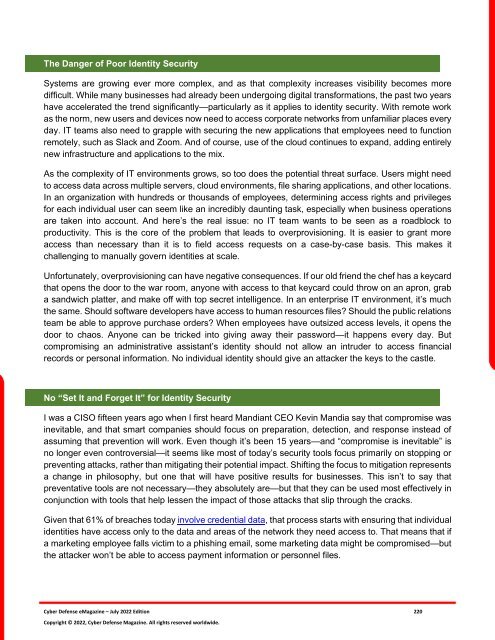Cyber Defense eMagazine July Edition for 2022
Cyber Defense eMagazine July Edition for 2022 #CDM #CYBERDEFENSEMAG @CyberDefenseMag by @Miliefsky a world-renowned cyber security expert and the Publisher of Cyber Defense Magazine as part of the Cyber Defense Media Group as well as Yan Ross, Editor-in-Chief and many more writers, partners and supporters who make this an awesome publication! Thank you all and to our readers! OSINT ROCKS! #CDM #CDMG #OSINT #CYBERSECURITY #INFOSEC #BEST #PRACTICES #TIPS #TECHNIQUES
Cyber Defense eMagazine July Edition for 2022 #CDM #CYBERDEFENSEMAG @CyberDefenseMag by @Miliefsky a world-renowned cyber security expert and the Publisher of Cyber Defense Magazine as part of the Cyber Defense Media Group as well as Yan Ross, Editor-in-Chief and many more writers, partners and supporters who make this an awesome publication! Thank you all and to our readers! OSINT ROCKS! #CDM #CDMG #OSINT #CYBERSECURITY #INFOSEC #BEST #PRACTICES #TIPS #TECHNIQUES
Create successful ePaper yourself
Turn your PDF publications into a flip-book with our unique Google optimized e-Paper software.
The Danger of Poor Identity Security<br />
Systems are growing ever more complex, and as that complexity increases visibility becomes more<br />
difficult. While many businesses had already been undergoing digital trans<strong>for</strong>mations, the past two years<br />
have accelerated the trend significantly—particularly as it applies to identity security. With remote work<br />
as the norm, new users and devices now need to access corporate networks from unfamiliar places every<br />
day. IT teams also need to grapple with securing the new applications that employees need to function<br />
remotely, such as Slack and Zoom. And of course, use of the cloud continues to expand, adding entirely<br />
new infrastructure and applications to the mix.<br />
As the complexity of IT environments grows, so too does the potential threat surface. Users might need<br />
to access data across multiple servers, cloud environments, file sharing applications, and other locations.<br />
In an organization with hundreds or thousands of employees, determining access rights and privileges<br />
<strong>for</strong> each individual user can seem like an incredibly daunting task, especially when business operations<br />
are taken into account. And here’s the real issue: no IT team wants to be seen as a roadblock to<br />
productivity. This is the core of the problem that leads to overprovisioning. It is easier to grant more<br />
access than necessary than it is to field access requests on a case-by-case basis. This makes it<br />
challenging to manually govern identities at scale.<br />
Un<strong>for</strong>tunately, overprovisioning can have negative consequences. If our old friend the chef has a keycard<br />
that opens the door to the war room, anyone with access to that keycard could throw on an apron, grab<br />
a sandwich platter, and make off with top secret intelligence. In an enterprise IT environment, it’s much<br />
the same. Should software developers have access to human resources files? Should the public relations<br />
team be able to approve purchase orders? When employees have outsized access levels, it opens the<br />
door to chaos. Anyone can be tricked into giving away their password—it happens every day. But<br />
compromising an administrative assistant’s identity should not allow an intruder to access financial<br />
records or personal in<strong>for</strong>mation. No individual identity should give an attacker the keys to the castle.<br />
No “Set It and Forget It” <strong>for</strong> Identity Security<br />
I was a CISO fifteen years ago when I first heard Mandiant CEO Kevin Mandia say that compromise was<br />
inevitable, and that smart companies should focus on preparation, detection, and response instead of<br />
assuming that prevention will work. Even though it’s been 15 years—and “compromise is inevitable” is<br />
no longer even controversial—it seems like most of today’s security tools focus primarily on stopping or<br />
preventing attacks, rather than mitigating their potential impact. Shifting the focus to mitigation represents<br />
a change in philosophy, but one that will have positive results <strong>for</strong> businesses. This isn’t to say that<br />
preventative tools are not necessary—they absolutely are—but that they can be used most effectively in<br />
conjunction with tools that help lessen the impact of those attacks that slip through the cracks.<br />
Given that 61% of breaches today involve credential data, that process starts with ensuring that individual<br />
identities have access only to the data and areas of the network they need access to. That means that if<br />
a marketing employee falls victim to a phishing email, some marketing data might be compromised—but<br />
the attacker won’t be able to access payment in<strong>for</strong>mation or personnel files.<br />
<strong>Cyber</strong> <strong>Defense</strong> <strong>eMagazine</strong> – <strong>July</strong> <strong>2022</strong> <strong>Edition</strong> 220<br />
Copyright © <strong>2022</strong>, <strong>Cyber</strong> <strong>Defense</strong> Magazine. All rights reserved worldwide.


















